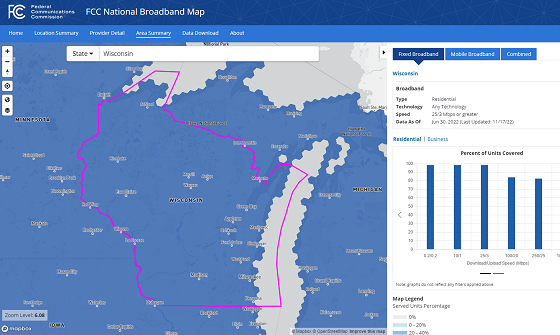
The Federal Communications Commission (FCC) recently released a draft of updated national broadband maps. This new map is the most detailed and current federal map of where broadband is and is not accessible throughout the country.
Is your broadband coverage reflected accurately?
The map displays address-level availability and data (as self-reported by internet service providers) for fixed and mobile broadband, as well as data aggregated to larger areas – e.g., state, county, census place, and congressional district. Data can be examined by exploring the map’s digital interface or by searching by state or address. The map also displays coverage data submitted by the provider.
In cases where the draft broadband map indicates broadband speeds that are not actually being observed at specific locations, it is important to challenge the results being presented on the map. Failure to do so could jeopardize a community’s ability to secure a portion of the more than $42 billion set aside for broadband expansion under the Broadband Equity Access and Deployment (BEAD) program. Simply put, if the speeds indicated on the map are incorrect for a location and you want to improve local broadband access, it is very important to challenge the results.
Individuals have until Jan. 13, 2023, to challenge any inaccuracies in the map.
“Centergy is asking everyone in the Region to visit the new FCC map and make sure it correctly reflects the access available at your homes,” said Angel Whitehead, President & CEO of Centergy, a nonprofit regional marketing and economic development organization serving Lincoln, Marathon, Portage, Adams, and Wood Counties.
“If areas are incorrectly finalized as having the access they do not, it will jeopardize the Central Wisconsin Region’s ability to access federal support for broad infrastructure,” she said.
These new maps will be used to allocate between $700 million and $1.1 billion for broadband expansion in federal Broadband Equity, Access and Deployment (BEAD) funds, said Wisconsin State Representative Calvin Callahan for the 35th Assembly District.
“The public’s help is needed to ensure these funds are allocated to the areas of our state where we need it most,” he said. “I encourage you to check out the map.” The map is available online at: http://broadbandmap.fcc.gov/home
The Wisconsin Broadband Office (WBO) has already submitted challenges to over 7,000 locations in Wisconsin, including homes and businesses missing from the map completely. But that doesn’t mean yours is one of them, so it’s important to report any discrepancies that affect your home or business.
To dispute your area’s part of the map, follow the instructions at: https://help.bdc.fcc.gov/hc/en-us/articles/10476040597787-How-to-File-an-Availability-Challenge
The FCC is seeking help to improve the data on the map by asking communities and individuals to submit a challenge or request a correction. There are three types of challenges: availability challenges, mobile availability challenges, and location challenges.
Questions about the process can be directed to Callahan’s office at: [email protected] or to the WBO at: [email protected].
Remember, to ensure valid challenges are incorporated into the map before federal funding allocations are made, challenges must be submitted by Jan. 13, 2023.
